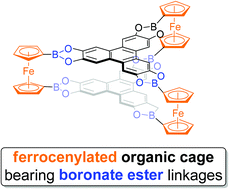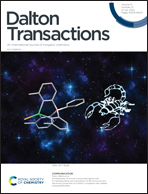Design of a D3h-symmetry prismatic tris-(ferrocene-1,1′-diyl) molecular cage bearing boronate ester linkages†
Abstract
This paper presents a simple, highly selective, and efficient (isolated yield of 68%) synthesis of a novel D3h-symmetry prismatic tris-(ferrocene-1,1′-diyl) organic cage (FcB-cage) by incorporating a boronate ester as a linkage motif. 1,1′-Diboronated derivatives of ferrocene and 2,3,6,7,10,11-hexahydroxytriphenylene (HHTP) were used as the starting materials. The synthesized cage was comprehensively characterized by spectroscopic and microscopic methods, powder X-ray diffraction, thermogravimetry and voltammetry. Cyclic voltammetry analysis revealed the electronic communication between the ferrocene units of the FcB-cage. In addition, to better understand the mechanism behind the synthesis of such a cage, as well as its geometric properties, we performed DFT calculations.



 Please wait while we load your content...
Please wait while we load your content...